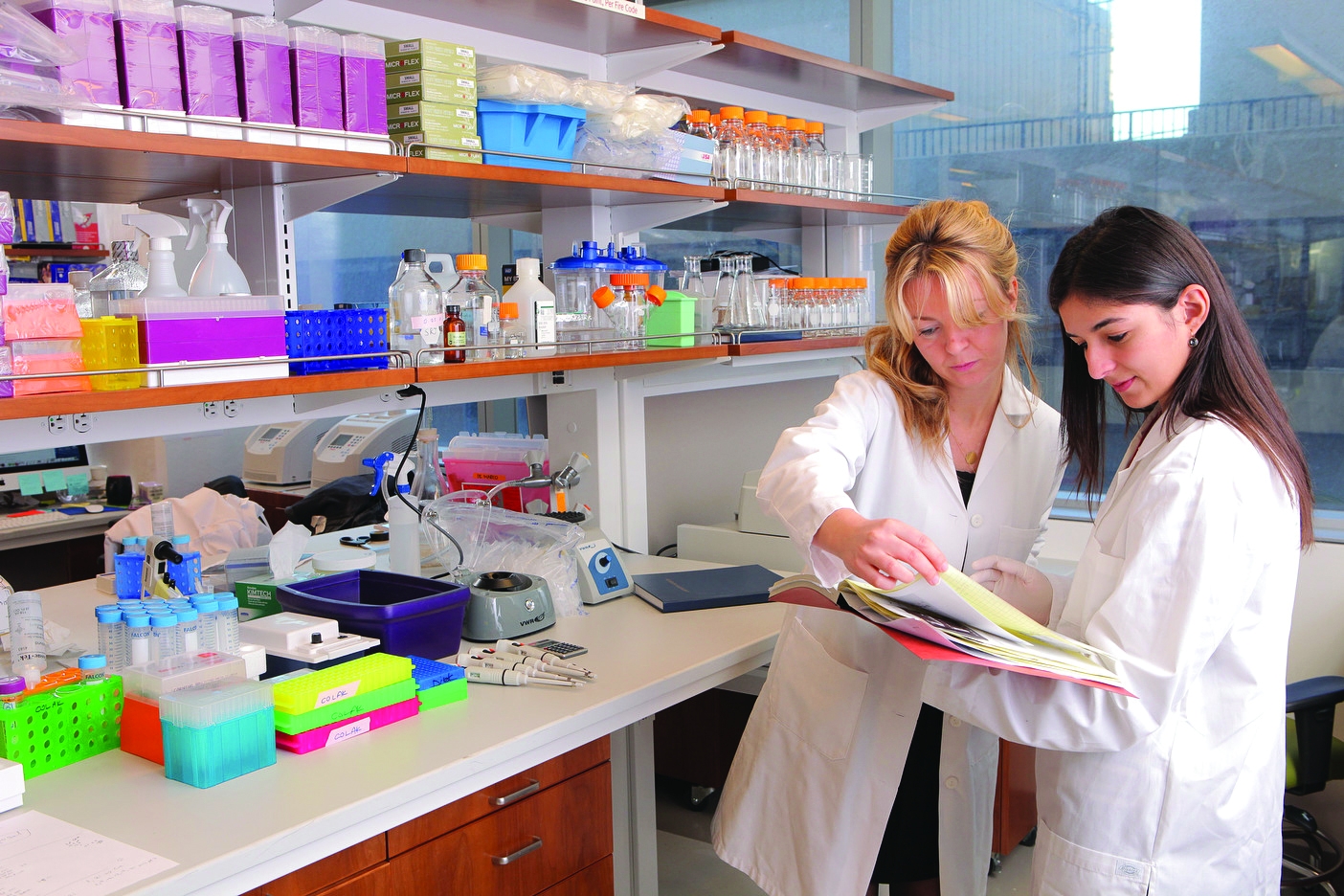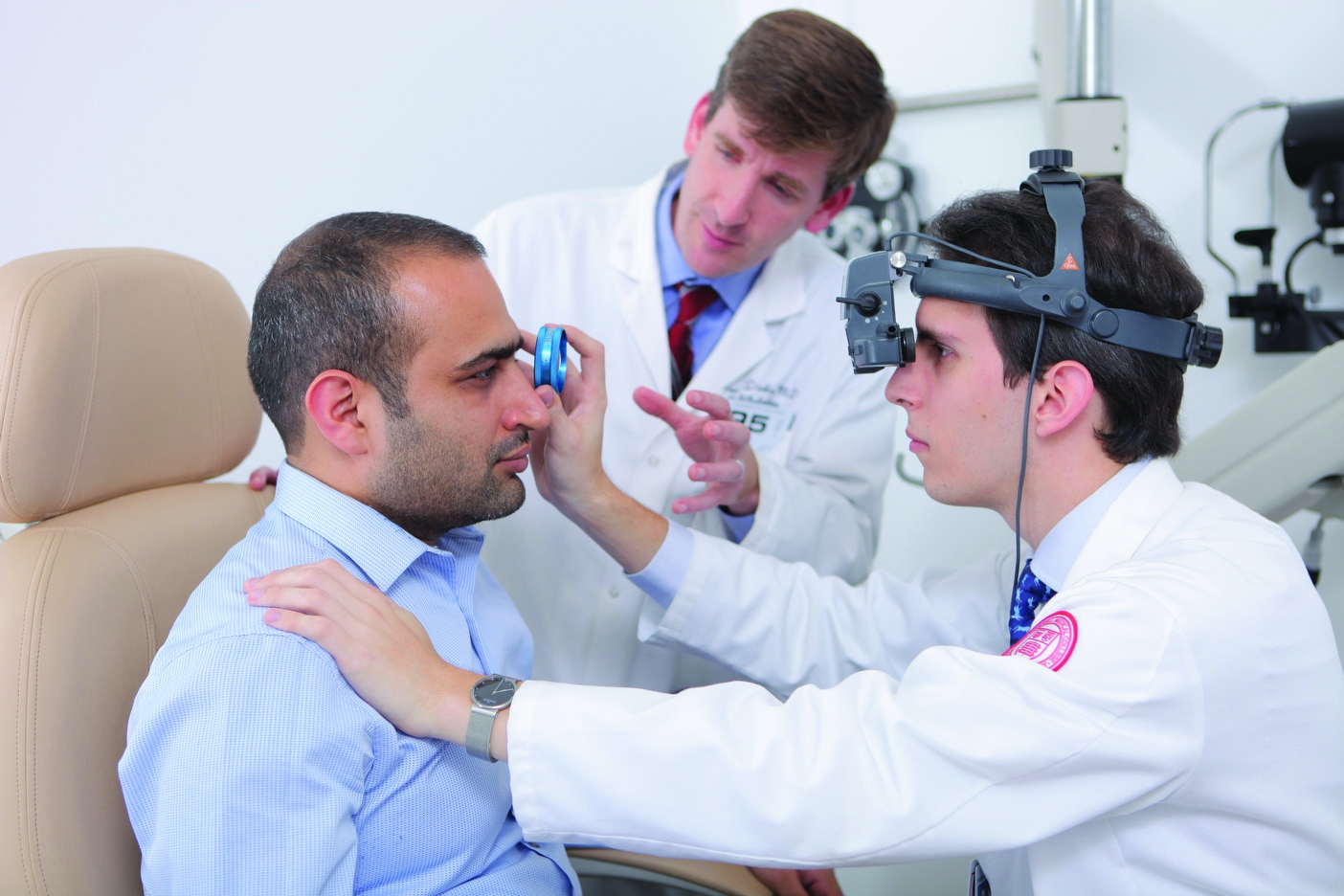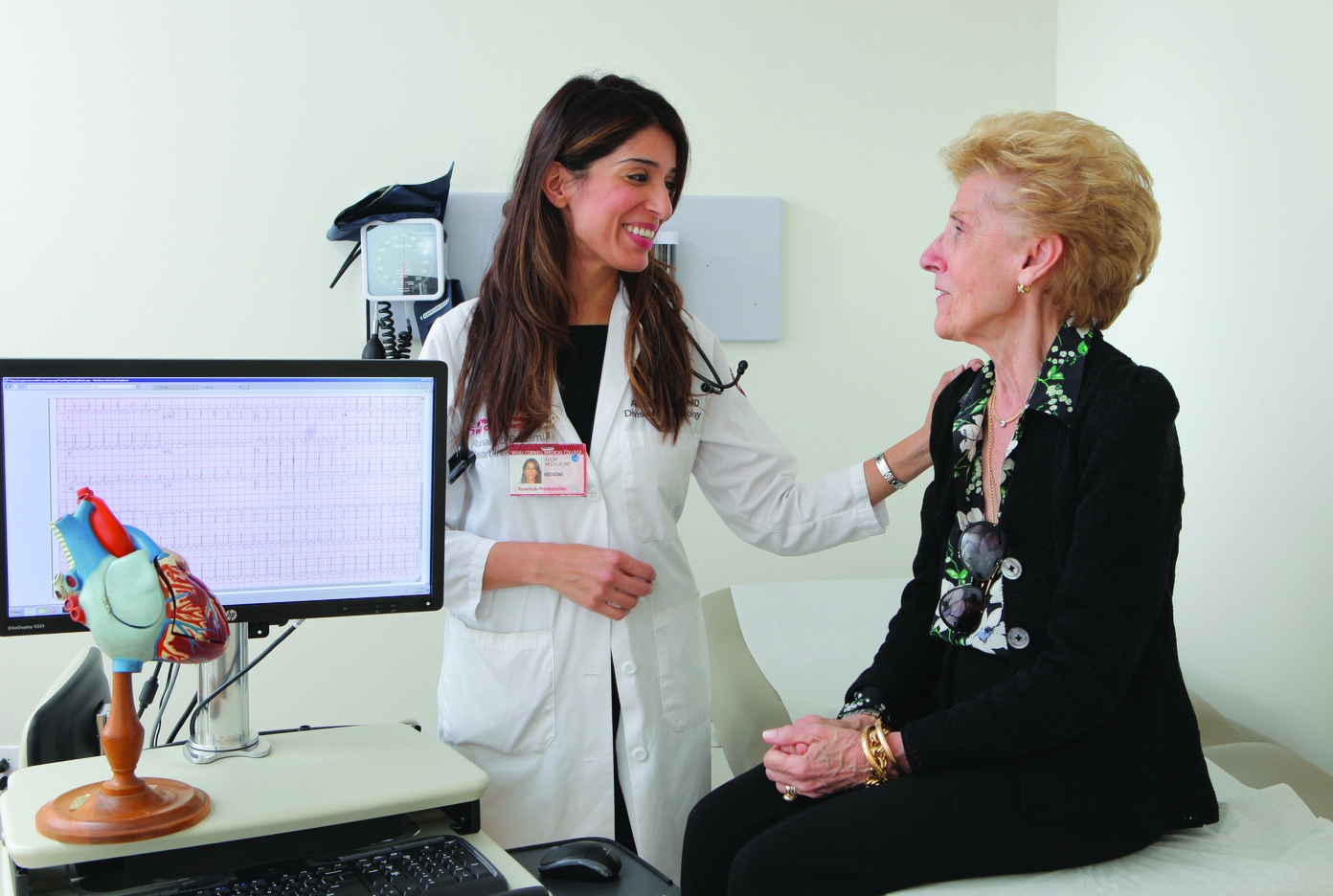BY JENNIFER MOON
PORTRAITS BY JOHN ABBOTT
It has been a dramatic transformation: from four temporary classrooms to a soaring campus on the Upper East Side, Weill Cornell has evolved over more than a century to meet dizzying changes in medical education, research and healthcare. Yet the sizable growth it has seen since its founding in 1898 — of expanded real estate, rapid advances in technology, and visionary philanthropy — has always been motivated by a desire to serve patients. Today, a new, unified identity as Weill Cornell Medicine reinforces the connection to those patients, who have been the constant, driving force behind the institution's mission.
Succinctly uniting Weill Cornell Medicine's three essential principles — to care, discover and teach — the new name, launched at the beginning of October, is the culmination of a strategic expansion that has positioned Weill Cornell Medical College, Weill Cornell Graduate School of Medical Sciences, and Weill Cornell Physician Organization to not only thrive in today's evolving healthcare landscape, but to lead the way in shaping medicine for the future. With history as precedent, Weill Cornell Medicine will surely succeed.
Weill Cornell Medicine has changed dramatically since those early days. In the first century since its founding, Cornell University Medical College moved from its initial location downtown into a newly built academic medical center on the Upper East Side. It formed overseas military hospital units during both world wars, weathered economic booms and downturns, and entered the new millennium as the newly renamed Weill Cornell Medical College. Already the 21st century has seen the creation of a branch campus in Qatar, a reinvigorated commitment to global health, two new buildings that truly embody the cutting edge in clinical care and biomedical research, and now, a Weill Cornell Medicine brand that fully captures the breadth of its endeavors.The first students to enroll in what was then Cornell University Medical College were taught in four temporary classrooms on the grounds of Bellevue Hospital. It was 1898, and many of their professors had recently seceded from nearby New York University to form their own medical school just a few blocks away. Anticipation was high for a new building being constructed on First Avenue between 27th and 28th streets, which would offer the latest in medical education and patient care. Among the planned amenities were recently invented X-ray machines and an early air-conditioning system that would afford students the opportunity for year-round investigations in gross anatomy.
Yet its foundation has stayed constant. Long before the medical school formalized a mission statement, the desire to improve the care available to patients drove all its efforts. In 1941, for example, Dean Dr. William Ladd wrote: "In the long run all of the teaching and investigative work of the school is directed toward the improvement of the healing art. To teach the art of healing and to restore the sick human being to as near a state of good health and able citizenship as possible is our basic reason for existence."
That commitment to patient care runs through the history of Weill Cornell Medicine to the present day. Back at the turn of the 20th century, many medical schools were for-profit institutions that focused little attention on science or clinical training. All too few students had actual contact with patients, and many sat in lecture halls for six or seven hours a day.
From the start, Weill Cornell Medicine was different. Its students, which included a large proportion of women at a time when most medical schools were single-sex, met some of the toughest admissions requirements in New York. They were taught the scientific basis of medicine in labs, dissecting rooms, and small-group study sessions, and they learned how to care for patients while shadowing their professors on the hospital wards and participating in weekly medical clinics. Generous support from the school's founding benefactor, Col. Oliver Payne, guaranteed that Weill Cornell Medicine could maintain its high academic standards without any sacrifices in quality.
Students and faculty learned and taught medicine, while firmly engaged with the needs of the surrounding community. Bellevue, the medical school's first site for clinical teaching and a bustling public hospital, provided a temporary haven for many indigent patients during a period of rapid industrialization and severe overcrowding in the city. The distinguished physicians on Weill Cornell Medicine's early faculty, such as the pioneering surgeon Dr. Lewis Stimson and the cardiologist Dr. Lewis Conner, served the elite of New York by making house calls; they also provided charity care at Weill Cornell Medicine's free dispensary for the impoverished.
In addition, Weill Cornell Medicine was one of the first medical schools in the country to address the needs of the emerging middle class. An innovative experiment called the Cornell Pay Clinic opened in 1921, charging moderate fees and offering comprehensive healthcare to middle-income patients who could not afford private physicians but were not entitled to free care. Initially, it charged an admission fee of $1 per visit, plus additional fees for special tests or services, ranging from 25 cents for prescription medications to $25 for an X-ray of the gastrointestinal tract. On the day it opened, the clinic was overwhelmed by visits and had to turn patients away in order to maintain the quality of care. Compared to similar facilities scattered around the country that were targeted at middle-class patients, the Cornell Pay Clinic offered both diagnosis and treatment by specialists in a private office environment. This model allowed for a personal relationship between doctor and patient — an amenity that was otherwise available only to the wealthy.
The Academic Medical Center: A New Focal Point For Education And Research

Discover: The Belfer Research Building, which opened early last year, serves as the hub for Weill Cornell Medicine's translational efforts. Dr. Dilek Colak, an assistant professor of neuroscience, in the lab with research associate Monica Ferrer Scorro in the research building.
A pivotal moment for Weill Cornell Medicine came in 1932 with the opening of a new medical center on York Avenue, built in partnership with New York Hospital. The decision to build a medical school and a teaching hospital adjacent to each other, made a decade before, was somewhat of a novelty. Academic medical centers had taken root in Europe, but were only gradually starting to emerge in the United States after the publication of Abraham Flexner's highly influential 1910 report on medical education. Weill Cornell Medicine's goal in tying itself even more tightly to New York Hospital, its clinical affiliate starting in 1912–1913, was to create a medical institution of the future. Its vision, which continues to this day, was to advance the field of medicine by acting on multiple fronts simultaneously: patient care, education, and research.
With a new medical center came major innovations. Dean Canby Robinson reorganized the faculty to create a full-time system of professors who received a salary and were expected to devote themselves primarily to teaching and research. Dr. George Heuer, chair of surgery, also introduced the first surgical residency program in New York City. Residents began receiving training for five or six years, as opposed to two, and were housed in the medical center, sometimes so successfully that they neglected to go outside for months at a time. They learned by performing most of the department's procedures themselves, while older surgeons were asked to serve primarily as advisors and assistants. These revolutionary changes soon spread to other departments, improving the standards of patient care and, in conjunction with sparkling new research laboratories and teaching facilities, transforming Weill Cornell Medicine into a genuinely modern medical institution.
A Growing Presence
Today Weill Cornell Medicine is leading the way in the development of precision medicine, an approach that aims to provide each patient with the right treatment at exactly the right time. By analyzing the complex interplay between genetics, lifestyle, and environment that makes each person unique, physicians and scientists are moving away from a one-size-fits-all mentality and entering into a new era of personalized, tailored treatments for individuals.
The tools that are making this transformation possible — from sophisticated imaging technologies to genomics — were unimaginable to bedside physicians practicing a hundred years earlier. The size and scope of today's medical schools would also prove astonishing to the faculty and students who moved into their state-of-the-art medical center in 1932, constructed at a cost of about $30 million, including land, buildings, and equipment.
Fueling Weill Cornell Medicine's considerable growth since that time was a constellation of forces that were shaping medicine, science and healthcare nationally. One of the most significant was an exponential increase in federal funding for medical research in the years following World War II. Between 1932 and 1957, the dollars spent on research at then-New York Hospital-Cornell Medical Center increased by 3,000 percent, largely due to an influx of funds from the federal government that continued through the 1960s. Weill Cornell Medicine was able to build a robust research infrastructure, recruit new investigators, and direct more resources toward finding better treatments for disease. At the same time, biomedical research became increasingly focused on the subcellular level, with scientists scrutinizing proteins and genes to understand how diseases develop. The basic sciences blossomed in this fertile environment, and in 1952 the Cornell University Graduate School of Medical Sciences was established in New York City. Its students benefited from Weill Cornell Medicine's close partnership with the cancer-focused Sloan Kettering Institute — one that continues today in concert with neighbor The Rockefeller University — and received advanced training in fields including microbiology, biophysics and biochemistry.

Teach: Today, under a new, patient-focused curriculum, medical students are exposed to healthcare delivery from their first day of school. Under the direction of Dr. Marc Dinklin '02, an assistant professor of ophthalmology, John Paddock '17, uses a special lens to look at the retina of ophthalmology fellow Dr. Ajay Jurangal in the Weill Greenberg Center.
The passage of Medicare and Medicaid in 1965, which provided federal health insurance to new populations of elderly and low-income patients, had a huge impact on Weill Cornell Medicine. Patient care became even more central to its mission, and a precursor to today's Physician Organization was quickly formed to ensure that all patients received the same high quality of care regardless of their ability to pay. Like other medical schools nationwide, Weill Cornell Medicine saw a dramatic increase in clinical revenues that mirrored the explosive growth in federal research funding of previous decades. Its York Avenue campus expanded, with the addition of the Wood Library and Research Building, Griffis Faculty Club and William Hale Harkness Building. In keeping with the spirit of the 1960s, students began playing a much more active role in their education and initiated community health projects in the Bedford-Stuyvesant neighborhood of Brooklyn and on the island of Jamaica to address the needs of under-served populations.
The makeup of Weill Cornell Medicine's student body itself became much more diverse with the launch of a robust affirmative action program. Dr. Roscoe Conkling Giles, the medical school's first African American graduate, received his medical degree in 1915, but between then and the 1970s, less than a dozen people of African descent had graduated as physicians. Through a summer research pipeline program, which continues today, as well as targeted academic and counseling services, Weill Cornell Medicine increased the number of students from groups underrepresented in medicine to at least 13 percent of each entering class during the 1970s. Weill Cornell Medicine's decision to keep admissions standards for minority and non-minority students the same contributed to a high level of academic success among its entire student body and led to a substantial increase in the number of African American graduates.
Despite these positive developments, Weill Cornell Medicine faced major challenges starting in the 1970s that continued for several decades. Federal funding for research stagnated, the nation's healthcare spending spiraled out of control and the government and private insurers began looking for ways to cut healthcare costs. Like other medical schools and hospitals, Weill Cornell Medicine responded to these financial constraints creatively, by becoming more cost-effective and resourceful in the teaching and practice of medicine. It forged mutually beneficial partnerships with its neighboring institutions and established programs that capitalized on each of their various strengths, such as the Tri-Institutional M.D.-Ph.D. Program with The Rockefeller University and the Gerstner Sloan Kettering Graduate School of Biomedical Sciences. The merger that resulted in the formation of NewYork-Presbyterian Hospital in 1996 represented a different approach, aimed at streamlining operations and consolidating departments across previously separate institutions.
Private philanthropy was crucial in propelling Weill Cornell Medicine, renamed in 1998 in honor of Joan and Sanford I. Weill, toward the new millennium. Extraordinarily generous and timely gifts from Ruth Uris, the Weills, Maurice and Corinne Greenberg, the Atlantic Philanthropies, Robert and Renée Belfer, and many others enabled the medical school to reach beyond the status quo and work toward actively shaping its own future. And that future became much brighter as a series of three strategic plans were implemented in succession.
Vigorous growth occurred in the basic sciences and medical education in the late 1990s. Today, under a new, patient-focused curriculum, medical students are exposed to healthcare delivery from their first day of school. As they follow a panel of patients with chronic illnesses for all four years of their medical education, students come to understand healthcare delivery as well as the physical, social and psychological effects of disease. They develop a powerful foundation for their medical practice, learning the value of treating patients holistically.
Clinical care continues to be the economic engine by which the institution is able to deliver that education. Construction of the Weill Greenberg Center in 2007 provided a headquarters for ambulatory care— expansion that has continued beyond campus. Since 2013, Weill Cornell Medicine has added more than 40 medical practices in Manhattan, Brooklyn and Queens and extended the services offered by Weill Cornell Imaging at NewYork-Presbyterian. More than 150 physicians at NewYork- Presbyterian/Lower Manhattan Hospital and a growing number from NewYork-Presbyterian/Queens also supplement the ranks of Weill Cornell Medicine faculty.
Healthcare, too, supports Weill Cornell Medicine's deep portfolio of biomedical research. The Belfer Research Building, which opened early last year, serves as the hub for Weill Cornell Medicine's translational efforts, housing some of the more than 50 physicians and scientists recruited since 2012. These investigators are spurring new biomedical research discoveries and applying them to patient care.
Today, Weill Cornell Medicine initiatives touch patients as far afield as Qatar, Tanzania, Haiti and Houston. Their goals — to bring new medicines and therapies to patients as quickly and efficiently as possible, to understand how and why disease strikes and to train the next generation of healthcare leaders — have become global in scale.
Yet those core aspirations — to care, discover and teach — have remained unchanged since the very beginning.
Jennifer Moon is the co-author, with Dr. Antonio Gotto, dean emeritus and a professor of medicine, of Weill Cornell Medicine: A History of Cornell's Medical School, to be published in Spring 2016 by Cornell University Press.
This story first appeared in Weill Cornell Medicine,Vol. 14, No. 3.

